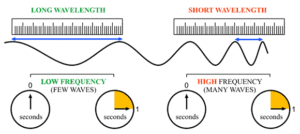What is radiation?
People around the world are exposed to radiation from a variety of natural and artificial sources. Radiation is energy travelling as waves or particles. Ionising radiation has enough energy to change the chemical composition of matter. Non-ionising radiation has less energy but can still excite molecules and atoms causing then to vibrate faster.
On this page
What are some natural sources of ionising radiation?
What are some artificial sources of ionising radiation?
Is artificial radiation more dangerous than natural radiation?
What are some examples of non-ionising radiation?
What is the electromagnetic spectrum?
What is the relationship between wavelength and frequency?
What are some natural sources of ionising radiation?
Ionising radiation is the energy produced from natural and artificial radioactive materials. It is present in the environment because of naturally occurring radioactive minerals remaining from the very early formation of the planet. This leads to exposure to gamma rays and radioactive radon gas from certain rocks and from radioactive material in our food and drink. We are also exposed to natural ionising radiation that comes from outer space and passes through the atmosphere of the planet – so-called cosmic radiation.
What are some artificial sources of ionising radiation?
There are three main sources of artificial ionising radiation. They are:
medical uses including diagnosis of many diseases and treatment of cancer;
industrial uses, mainly in measurement and scientific research; and
fallout from nuclear weapons testing and accidents around the world.
The figure below shows the relative annual per capita dose to the population from the various radiation sources
Pie chart showing annual per capita radiation dose from natural and medical sources - cosmic (0.3 mSv); Terrestrial (0.6 mSv); Radon and progeny (0.2 mSv); Potassium-40 in the body (0.2 mSv); Uranium/Thorium in the body (0.2 mSv); Atmospheric weapons testing (<0.005 mSv); Medical (1.7 mSv)
Is artificial radiation more dangerous than natural radiation?
The damaging effects of ionising radiation come from the packages of high energy that are released from radioactive material. Although different types of ionising radiation have different patterns of energy release and penetrating power (see ionising radiation topics) there is no general property that makes artificial ionising radiation different and more damaging than the ionising radiation that comes from natural radioactive material. This means that we can make direct comparisons between doses from artificial sources of ionising radiation and those from natural sources.
What are some examples of non-ionising radiation?
Solar radiation consists of several different forms of non-ionising radiation and many modern technologies such as, power-lines, electrical equipment and mobile phone systems, also produce forms of non-ionising radiations.
We cannot eliminate radiation from our environment but by having a good understanding of radiation and controlling our exposure, we can reduce our risk.
What is the electromagnetic spectrum?
The electromagnetic spectrum includes radio waves, microwaves, infrared rays, light rays, ultra violet rays, X‑rays and gamma rays. All electomagnetic radiation is transmitted through empty space at 3.0 X 108 metres per second (300 thousand kilometres per second).
The different forms of electromagnetic radiation are distinguished from each other by:
their wavelength
the amount of energy they transfer
These properties also determine their ability to travel through objects, their heating effects and their effect on living tissue.
Image depicting the electromagnetic spectrum - showing where different types of radiation fall within the spectrum and samples of sources of radiation
What is the relationship between wavelength and frequency?
Sometimes electromagnetic radiation is described using its frequency rather than its wavelength. These two characteristics are closely related.
If we could watch a wave of electromagnetic radiation pass, the wavelength would be the distance between two adjacent wave crests, the frequency would be the number of wave peaks that passed in a given time. Since electromagnetic radiation travels at a constant speed in a constant environment, radiation with a longer wavelength would have fewer waves passing in a given time (lower frequency) and radiation with a shorter wavelength would have more waves passing in a given time (higher frequency). When wavelength increases, frequency decreases and visa versa.
Illustration of wavelength and frequency
The hertz is the unit used to measure frequency. A measured frequency of one hertz(Hz) represents one wavelength per second or one cycle per second. The range of frequencies within the electomagnetic spectrum is great resulting in the common use of a series of units:
one kilohertz(kHz) is one thousand hertz (1000 Hz)
one megahertz(MHz) is one million hertz (1,000,000 Hz)
one gigahertz(GHz) is one thousand million hertz (1,000,000,000 Hz)
What is ionising radiation?
Ionising radiation has more energy than non-ionising radiation; enough to cause chemical changes by breaking chemical bonds. This effect can cause damage to living tissue.
What is non-ionising radiation?
Non-ionising radiation is found at the long wavelength end of the spectrum and may have enough energy to excite molecules and atoms causing then to vibrate faster.
Units of ionising radiation measurement
There are many quantities in radiation that use unique units. Italy uses the International system (SI) of units.


